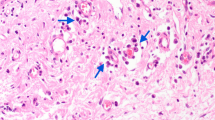Abstract
The normal ocular surface is composed of corneal, limbal, and conjunctival epithelial cells, which maintain its integrity. Severe damage to limbal epithelial cells from Stevens-Johnson syndrome (SJS), ocular cicatricial pemphigoid (OCP) and chemical burns may lead to loss of the limbal epithelial cells.1 Such limbal cell deficiencies are some of the greatest challenges facing todays clinician.2–6 During the chronic cicatricial phase, most patients with ocular surface disease—experience numerous problems, including symblepharon, persistent epithelial defects, conjunctivalization, and pathological keratinization. Some of these problems can be managed by antibiotics, corticosteroids and immunosuppressants. However, the pathological keratinization of ordinarily nonkeratinized corneal and conjunctival epithelium is a serious and potentially debilitating problem that is difficult to manage pharmacologically.
Access this chapter
Tax calculation will be finalised at checkout
Purchases are for personal use only
Preview
Unable to display preview. Download preview PDF.
Similar content being viewed by others
References
S.C.G. Tseng, J.J.Y. Chen, A.J.W. Huang, F.E. Kruse, S.L. Maskin, R.J.F. Tsai. Classification of conjunctival surgeries for corneal diseases based on stem cell concept. Ophthalmic Clin North Am. 3: 595 (1990).
R.J.F. Tsai, S.C.G. Tseng. Human allograft limbal transplantation for corneal surface reconstruction. Cornea. 13: 389 (1994).
E.J. Holland, G.S. Schwartz. The evolution of epithelial transplantation for severe ocular surface disease and a proposed classification system. Cornea. 15(6): 549 (1996).
G. Y.C. Auguste, J.F. George, K. Michael. Management of conjunctival cicatrizing diseases and severe ocular surface dysfunction. Surv Ophthalmol. 43: 19 (1998).
K. Tsubota, Y. Satake, M. Kaido, et al. Treatment of severe ocular surface disorders with corneal epithelial stem-cell transplantation. N Engl J Med. 340:1697 (1999).
N. Koizumi, T. Inatomi, T. Suzuki, C. Sotozono, S. Kinoshita. Cultivated corneal epithelial transplantation for ocular surface reconstruction in acute phase Stevens-Johnson syndrome. Arch Ophthalmol. 119(2): 298 (2001).
I. Beitch. The induction of keratinization in the corneal epithelium; a comparison of the dry eye and vitamin A-deficient eye. Invest Opthalmol Vis Sci. 9: 827 (1970).
J.D. Nelson, V.R. Havener, D. Cameron. Cellulose acetate impression of the ocular surface. Arch Ophthalmol. 101: 1869(1983).
S.C.G. Tseng. Staging of conjunctival squamous metaplasia by impression cytology. Ophthalmology. 92: 728 (1985).
R.A. Ralph. Conjunctival goblet cell density in normal subjects and dry eye syndromes. Invest Opthalmol. 14: 299 (1975).
J. Friend, T.C. Kiorpes, R.A. Thoft. Conjunctival goblet cell frequency after alkali injury is not accurately reflected by aqueous tear mucin content. Invest Opthalmol Vis Sci. 24: 612 (1983).
S.C.G. Tseng, L.W. Hirst, A.E. Maumenee et al. Possible mechanism for the loss of goblet cells in mucin-deficient disorders. Ophthalmology. 91: 545 (1984).
S. Kinoshita, T.C. Kiorpes, J. Friend, et al. Goblet cell density in ocular surface disease. Arch Ophthalmol. 102: 1049 (1984).
K. Nishida, K. Yamanishi, K. Yamada, et al. Epithelial hyperproliferation and Transglutaminase 1 gene expression in Stevens-Johnson syndrome conjunctiva. Am J Pathol. 154: 331 (1999).
T. Nakamura, K. Nishida, A. Dota, M. Matsuki, K. Yamanishi, S. Kinoshita. Elevated expression of transglutaminase 1 and keratinization-related proteins in conjunctiva in severe ocular surface disease. Invest Ophthalmol Vis Sci. 42: 549 (2001).
Author information
Authors and Affiliations
Editor information
Editors and Affiliations
Rights and permissions
Copyright information
© 2002 Kluwer Academic/Plenum Publishers
About this chapter
Cite this chapter
Kinoshita, S., Nakamura, T., Nishida, K. (2002). Pathological Keratinization of Ocular Surface Epithelium. In: Sullivan, D.A., Stern, M.E., Tsubota, K., Dartt, D.A., Sullivan, R.M., Bromberg, B.B. (eds) Lacrimal Gland, Tear Film, and Dry Eye Syndromes 3. Advances in Experimental Medicine and Biology, vol 506. Springer, Boston, MA. https://doi.org/10.1007/978-1-4615-0717-8_90
Download citation
DOI: https://doi.org/10.1007/978-1-4615-0717-8_90
Publisher Name: Springer, Boston, MA
Print ISBN: 978-1-4613-5208-2
Online ISBN: 978-1-4615-0717-8
eBook Packages: Springer Book Archive




